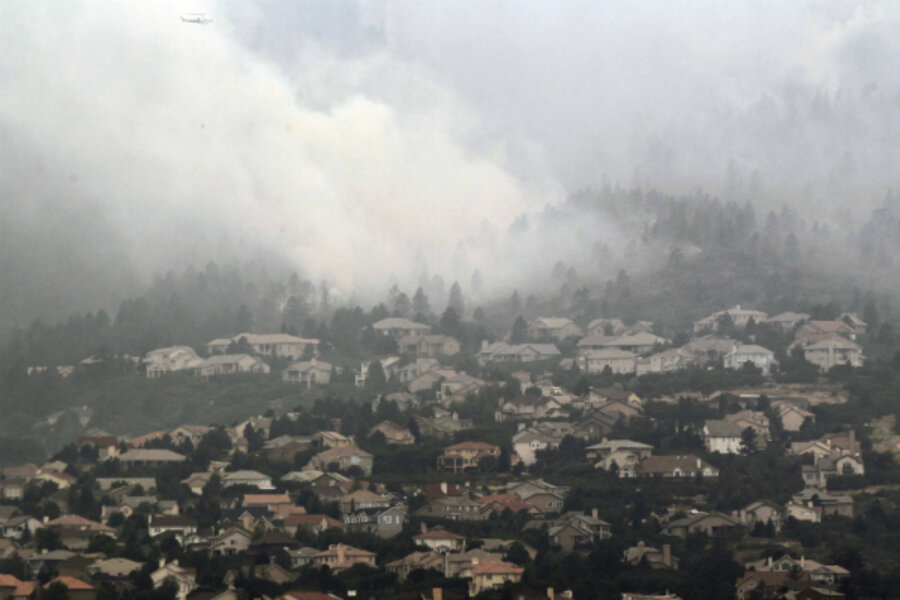Surging Colorado wildfires forcing tens of thousands to flee
Loading...
| Boulder, Colo.
Wildfire worries in Colorado surged Wednesday, as fires threatened heavily populated areas of the state in and around Colorado Springs and Boulder – and a dangerous combination of high winds, heat, and drought conditions compounded firefighters' difficulties. With three major fires burning within its borders, the state scrambled to allocate resources, and President Obama on Wednesday announced he would visit Colorado Springs at the end of this week to view the damage.
Near Colorado Springs, the Waldo Canyon fire ballooned Tuesday night, as high winds caused the fire to double in size to more than 15,000 acres. The city evacuated about 26,000 more people overnight, and on Wednesday, additional families in parts of Woodland Park – to the Northwest side of the fire – and Crystola were given the evacuation order.
More than 32,000 people have been evacuated so far, including residents of the US Air Force Academy. By Wednesday, the fire had encroached 10 miles onto Academy grounds, and firefighters were doing their best to hold the flames back. "We're facing a potentially devastating disaster right here," Academy superintendent Lt. Gen. Mike Gould told reporters in a press conference. Conditions improved enough Wednesday afternoon that the Academy briefly allowed some evacuees back into their base housing to collect more belongings.
Already, the fire has destroyed dozens of homes around Colorado Springs, particularly in the Mountain Shadows neighborhood, and is threatening thousands more.
It was like looking at the worst movie set you could imagine," Colorado Gov. John Hickenlooper (D) told the Associated Press after flying over the fire late Tuesday. "It's almost surreal. You look at that, and it's like nothing I've seen before."
About half of the active federal wildfire-fighting resources are now staged in Colorado, including firefighters, helicopters, and air tankers. And by midafternoon Wednesday, several massive C-130 air tankers had dropped about 27,000 gallons of fire retardant on the Waldo Canyon fire.
Meanwhile, Boulder, Colo., to the northwest of Denver, faced its own fire worries after a lightning strike sparked several fires Tuesday. While most of the fires were quickly contained, one just outside city limits quickly grew to 300 acres and resisted firefighters' efforts to contain it.
Smoke billowed out behind the Flatirons – the striking ridge on Boulder's southwest side – Tuesday and Wednesday, and the city sent "pre-evacuation" alerts to nearly 2,500 South Boulder telephone numbers, asking residents to be prepared to evacuate quickly should the order come. Planes flew over the site Wednesday, including two C-130 air tankers dropping slurry. So far, just 28 homes have been evacuated, but the fire's proximity to densely populated areas, combined with high winds and treacherously dry conditions, have Boulder residents on edge.
And firefighters were worried about possible winds and continued hot, dry conditions in the forecast. "Mother Nature has not been cooperating around Colorado, and we're not expecting any different this afternoon," Boulder fire spokeswoman Kim Kobel said in a media briefing Wednesday.
Near Fort Collins, firefighters were making progress Wednesday on fighting the High Park fire, sparked by lightning on June 9, which has cost at least $33 million and destroyed 257 homes, making it the most destructive fire in the state's history. Many evacuated residents were being allowed back to their homes Wednesday, and the fire stands at 65 percent containment.
Already, the 2012 fire season is looking to be Colorado's worst in at least a decade. In 2002, the Hayman fire burned 138,000 acres in an area northwest of Colorado Springs, and still stands as the state's largest wildfire.
Part of the problem, say forest scientists, are underlying forest conditions in the dense ponderosa pine-Douglas fir forests along Colorado's Front Range that make a drought year like this one particularly incendiary.
A combination of fire suppression, logging, and other changes in management have reduced the smaller, naturally occurring fires that kept forests diverse and thinned out and created natural fuel breaks, says Merrill Kaufmann, an emeritus forest scientist at the Rocky Mountain Research Station in Fort Collins, who researched front range forests in his decades of work with the US Forest Service.
Several of the state's biggest fires from the past couple decades, Mr. Kaufmann says, "produced about half the crown fire area we would have expected from the last 100 years – but instead of those fires occurring in smaller patches that would have broken up the whole forest, they occurred in just a few places, leaving most of the area where a crown fire can get started, and there's no way to stop it."
Combine those conditions with a drought year – like Colorado and most of the West is currently experiencing – and numerous sources of fire, from lightning strikes to a careless individual, and the result is numerous out-of-control wildfires.
"It's really an untenable situation," says Kaufmann.








